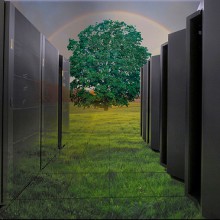Green Technology and Servers
You might well believe that computer servers consume vast amounts of energy, not only due to the fact that they run non-stop 24 hours a day, 7 days a week, but also because they require heavy-duty cooling systems and related equipment to keep them functioning properly. While it may be true that older server technology was less than efficient, modern green technology can significantly reduce both the energy consumption and the carbon footprint of today’s computer servers.
Virtual Servers

A virtual server is simply software that has been coded with the ability to host multiple operating systems within the same physical server, generally run by a company that specializes in operating virtual servers. If you wish, you can now even operate virtual servers from virtual desktops. By doing so, the requirements of a localized server room may be drastically reduced or even eliminated, reducing or eliminating its power consumption and heat output in favor of a more efficient virtual server that is hosted off-site.
In addition, virtual servers also allow users to connect to and work from a network more quickly and easily. This is because a virtual server can be set up to the ideal specifications for the tasks it will be handling, ensuring that it has sufficient processing power for your needs but also that none goes to waste.
In addition to the environmental benefits of virtual servers, this type of technology can be useful in several other ways. For example, software transfers and upgrades become a breeze, backups and restorations are far less stressful than with physical servers and running tests and routine maintenance is much easier.
Dual-Core & Multi-Core Processor Servers
If you prefer to use physical, on-site servers, one way to help alleviate heat output, maximize performance and improve efficiency is to opt for dual-core or multi-core servers. This simply means that the server uses two or more processor cores to accomplish tasks. This allows it to analyze, send and receive data much more quickly because it can assign different tasks to different processors.
This improved efficiency and processing speed means that high-tech multi-core processor servers generally consume less energy (all other factors being equal) than old-fashioned servers. Typically, a dual-core processor can output twice the amount of processing power using the same amount of energy that a single core processor would require. Over the long run, this can drastically reduce the amount of energy needed to operate a server.
Server Cooling
Although running more efficient servers will help decrease your environmental impact, you will still need a way to cool the physical servers you do operate. An environmentally-friendly technique for cooling these physical servers is to mount the actual server units within a basin filled with mineral oil. The server units that are within a basin such as this have their circuitry boards, structural cases and other components water-proofed as well as all moving cooling fans removed from the units. While a cooling fan within a server helps to move heat out of the unit when not submerged, it is usually not efficient enough to cool the unit to an ideal temperature.
Since the servers are submerged within the mineral oil, they run at a much cooler temperature compared to a standard installation. Submerging the servers within a mineral oil-filled basin also means that less energy is consumed cooling and operating them. Simply be careful that you hire a technician who is trained in this technique to handle the setup process for you to ensure that your servers are not damaged.
About Matt Smith
Matt Smith is a Dell employee who writes to help raise awareness on the topic of Servers and other network management subjects.
Related Articles
Groundwater Flows through New Datacenters










